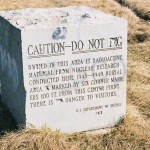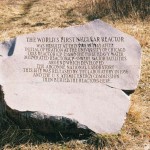
In the early 1940s, the race to build an atomic weapon was raging, and the Manhattan Project was in full swing. While scientists like Oppenheimer toiled in New Mexico designing the bomb, physicists such as Enrico Fermi worked to assemble the world’s first generation of nuclear reactors to decipher nuclear physics. It is at Site A where several of these first reactors would be assembled and tested, as well as eventually laid to rest in a concrete sarcophagus at Plot M.
Introduction
The Manhattan Project, officially starting in 1942, took advantage of several discrete locations across the United States, from the Manhattan District HQ in Oak Ridge, Tennessee, to the isolated Los Alamos Laboratory in New Mexico. Scientists, engineers, and universities across the nation worked to understand various facets of nuclear physics with the ultimate goal of building the largest bomb ever imagined.

At the University of Chicago, under the stands of Stagg Field, renowned physicist Enrico Fermi led a team in assembling the world’s first nuclear reactor — Chicago Pile-1. The reactor was comprised primarily of graphite blocks used to moderate the reaction, along with several tons of uranium metal and uranium oxide. Described by Enrico Fermi himself as “a crude pile of black bricks and wooden timbers”, it bore little, if any, resemblance to the reactors that would come after.
On December 2, 1942, Chicago Pile-1 became the world’s first nuclear reactor to go critical (achieve a self-sustaining reaction), outputting a steady 0.5 Watts of power for four and a half minutes. While a great triumph, it was quickly realized that a nuclear device should not be run at a university in central Chicago. In collaboration with the university and the Army, a new Metallurgy Laboratory was established at Site A in Red Gate Woods.

The Metallurgy Laboratory
With new requirements in mind, a new set of objectives were created, setting the basis for the scope of the project:
“The Pile Project […] was organized to investigate the problems involved in the establishment of a controlled self-sustaining “chain reaction,”* to develop materials and methods most suited for the process, to design and construct the necessary research and manufacturing facilities, and to produce the quantities of “plutonium”* dictated by military requirements in the shortest possible time”
-Objectives (Manhattan District, 1947).
For the sake of security, public safety, and overall convenience, the requirements specifically requested “The acquisition of an area of land, sufficiently large for the production plants and attendant service and housing facilities, yet remote from large centers of population, and near abundant supplies of water and electrical power” (Manhattan District, 1947). Just months before, the Army Corps of Engineers had leased over a thousand acres from the Cook County Forest Preserve to build a new research facility. This land, dubbed simply “Site A” would become the location of the new Metallurgy Laboratory.
At the new project site, known colloquially as “Argonne” (a French forest made known from WWI), CP-1 was rebuilt as CP-2 and testing continued. Unlike its earlier incarnation, CP-2 was “not just a pile of uranium and graphite, CP-2 had an intricate system of rods and stringers that allowed scientists to control the reactions” (Karamanski, 2013). CP-2 also featured thick lead and wooden walls to act as radiation shielding, a feature CP-1 lacked.
In the meantime, Army leadership was becoming more familiar with the importance of plutonium to the atomic bomb project. In early October of 1942, the newly appointed Manhattan commander General Groves attended several policy meetings with the Metallurgical Laboratory Technical Council. Impressed with how things were running, Groves proposed the scientists pursue multiple designs concurrently, regardless of cost. Groves is quoted as concluding “the plutonium process [of all the methods proposed] seemed to offer … the greatest chances for success in producing bomb material” (Jones, 1985).
Further experimentation was conducted with the construction of Chicago Pile-3, the world’s first water-cooled reactor. Originally designed as a plutonium production reactor and activated on May 15, 1944, CP-3 was soon converted to a research reactor after another location in Hanford, Washington began successfully producing plutonium. Ultimately, neither CP-2 nor -3 contributed any plutonium to the weapons program, but contributed greatly to the understanding of plutonium-producing reactors.
Outside of the experiments being performed on the reactors, the personnel of Site A began to realize that the Metallurgy Laboratory was in a way an experiment itself, as some scientists experienced minor health problems related to the materials and radiation involved. As they learned more about the effects of radiation on the human body from their own experiences, several medical experts also conducted experiments with mice, regularly discovering new evidence to support or debunk previous research.

Despite the very real dangers associated with the work, many of the scientists recount exciting moments of discovery. Indeed, observations and measurements provided by the Metallurgy Laboratory informed the team led by Oppenheimer in New Mexico, and even contributed towards the use of nuclear reactors as a power source in applications such as submarines (Karamanski, 2013).
On To Greater Things
Over time, it was realized that more space was needed to continue the experiments, and an area was selected even further away from more populated areas, in DuPage County. After the end of the war, the Atomic Energy Act of 1946 was passed, giving the Atomic Energy Commission (AEC) control over Argonne National Laboratory from the Army Corps of Engineers. The AEC assigned the new laboratory the role of “principle reactor development center” (Karamanski, 2013).
By the early 1950s, the Site A reactors had long outlived their usefulness, and were ordered to be decommissioned by Argonne director Walter Zinn. Any salvageable fuel was transferred to CP-5 at the DuPage site, and the rest of the contaminated material was disposed.
Contamination & Cleanup
Beginning in 1944, contaminated materials from Site A were being disposed in the nearby Plot M. Until the introduction of new disposal regulations in 1948, waste would simply be burned or buried with dirt. The new regulations required that waste be put in steel drums before disposal, though these barrels were later removed by the AEC in 1956. The remaining potentially harmful waste was sealed in an inverted concrete box and promptly buried.
Continuing in the 1950s, the AEC promised to “remove, destroy, or render harmless” (Karamanski, 2013) any materials that could harm the public. Over the course of a few years, they methodically dismantled the remaining reactors at the site, removing high-level radioactive fuel and coolant and sending it to Oak Ridge for disposal. Lower-level waste was sealed in concrete and buried in a trench.
With some closure regarding the hazards of waste, Site A/Plot M was transferred to the Cook County Forest Preserve District. Surveys tracking radioactivity were periodically performed by the AEC until its dissolution and later by the Department of Energy. However, these surveys were simplistic in scope and limited to testing the surface.
Concern over contamination at other nuclear laboratories in the 1980s brought more scrutiny to Site A and Plot M. When traces of materials like tritium and cesium were detected in nearby wells and woods, public outcry demanded an intervention. Argonne and the DoE committed a total of $29.1 million to survey and rehabilitate the area, including removing large swaths of soil and debris (Karamanski, 2013). In September of 1997, the area was deemed safe and reopened to the public.
Conclusion
To this day, Site A and Plot M – better known now as Red Gate Woods – undergo regular monitoring and remain safe. Now completely open to the public, there is an extensive system of trails snaking through the woods, along with small lakes and places for picnics. The only remaining signs of the Manhattan Project are the two small monuments off the side of two of the trails. One of these monuments commemorates the world’s first successful nuclear reactor. The other cautions about the remains of the program buried below.
Primary Sources
- Manhattan District (1947). Manhattan District History, Book IV – Pile Project, X-10, Volume 1 – General Features.
- Manhattan District (1947). Manhattan District History, Book IV – Pile Project, X-10, Volume 2 – Research, Part 1 – Metallurgical Laboratory.
- Jones, Vincent (1985). Manhattan: The Army and the Atomic Bomb. U.S. Army Center of Military History, 185-193.
Secondary Sources
- Alario, Margarita; Freudenburg, William (2003). “The Paradoxes of Modernity: Scientific Advanced, Environmental Problems, and Risks to the Social Fabric?” Sociological Forum 18.2: 204-206.
- Ackland, Len (1982). “Dawn of the Atomic Age,” Chicago Tribune.
- Lowrey, Jeannette (1947). The Scientific Monthly 65.6: 470-474.
- Karamanski, Theodore (2013). “Red Gate Woods: ‘Site A’,” Forest Preserves of Cook County.
Further Reading
- Wikipedia (2016). Argonne National Laboratory – History.
- Wikipedia (2016). Chicago Pile-1.
- Wikipedia (2016). Metallurgical Laboratory.
- Wikipedia (2016). Red Gate Woods.
- Wikipedia (2016). Site A/Plot M Disposal Site.
